Facebook’s Smart Glasses Peek Out from the Curtain.
 Tuesday, April 7, 2020 at 3:00PM
Tuesday, April 7, 2020 at 3:00PM 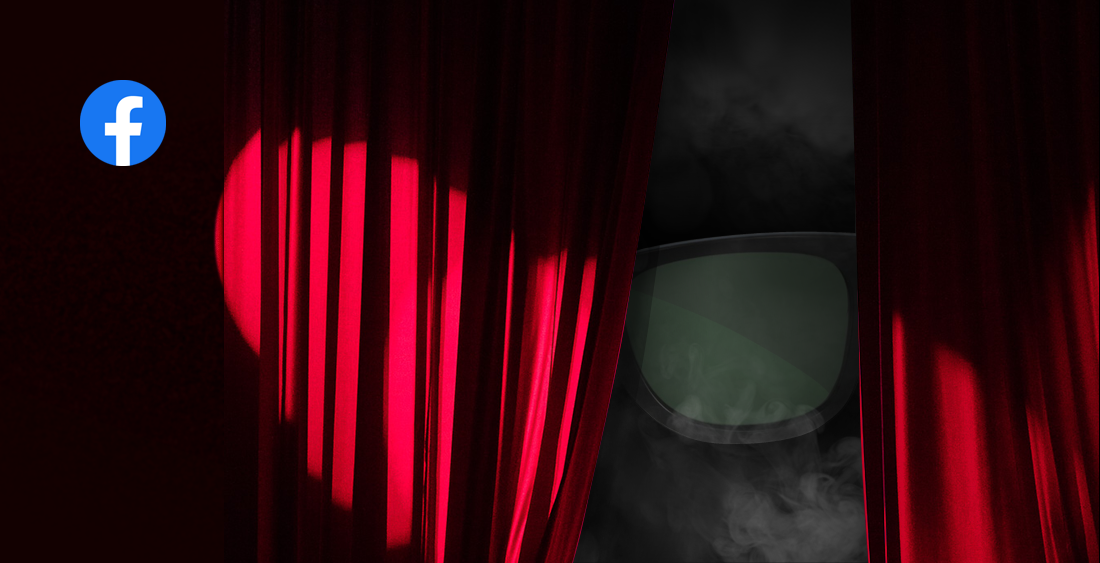
FACEBOOK’S SMARTGLASSES ARE TAKING SHAPE
A week ago today The Information broke a story about Facebook’s “exclusive” deal with Plessey. Plessey is a UK based manufacturer of MicroLED displays. These displays are used as the light-engine to drive a near-eye optics display, more specifically a waveguide.
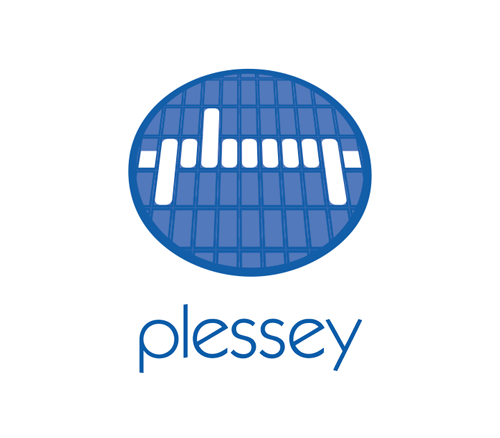 The story was retreaded through the tech-press by the usual suspects. As it made the rounds I noticed most of the coverage had a few things in common: one, the allegation that anonymous sources claimed Apple wished to buy them, but they chose an exclusivity contract with Facebook instead; secondly that some of the tech journalists—typically generalists, without a focus on near-eye optics—seemed unclear about the actual technology that Plessey produces. The intention of this article is to offer some clarification of what Plessey does, and what Facebook gets, and cover the collection of relationships Plessey brings to the table.
The story was retreaded through the tech-press by the usual suspects. As it made the rounds I noticed most of the coverage had a few things in common: one, the allegation that anonymous sources claimed Apple wished to buy them, but they chose an exclusivity contract with Facebook instead; secondly that some of the tech journalists—typically generalists, without a focus on near-eye optics—seemed unclear about the actual technology that Plessey produces. The intention of this article is to offer some clarification of what Plessey does, and what Facebook gets, and cover the collection of relationships Plessey brings to the table.
LET’S GET APPLE OUT OF THE WAY
Might Apple have made a bid? Maybe. Maybe not. The Information invokes Apple in the headline, citing two anonymous sources. When a story ostensibly about a Facebook deal, is headlined instead by name-dropping Apple, it says a lot less about this deal and a lot more about the power of Apple’s brand. Call it a pet-peeve, but leading every headline about other companies not Apple, with a headline invoking Apple—in order to drive site traffic—is kind of lame, and used to exhaustion. The fact that the story is otherwise nothing about Apple makes it an annoying click-bait technique.
The intrigue over “Did Facebook steal the deal from Apple?” is also a huge distraction from what is otherwise a genuinely compelling story, one that I feel got lost. That’s the story I hope to deliver for you here… so let’s move on.
PLESSEY’S PREEXISTING CONTRACTS
Besides Facebook, Plessey has preexisting contracts, perhaps most notably with Vuzix. Last May, Plessey entered into what was described as a “long term” relationship to supply the light-engine for Vuzix’s waveguide display used in their flagship Vuzix Blade smartglasses. While the terms of the contract were not publicly delineated, given the joint press release described it as “long term,” I’m willing to assume this meant a minimum of at least a year. So Facebook’s “exclusive” contract to buy up all of Plessey’s manufacturing capacity would appear—based on the existing coverage—to violate (or to have bought out) Vuzix’s own supplier relationship with Plessey. While I have no insider scoop, if this were the case, the market would have been expected to respond in a negative fashion, and it did not. In spite of claims of exclusivity, this leads me to believe that Plessey’s supplier relationship with Vuzix was likely somehow preserved, perhaps grandfathered into the deal… details.
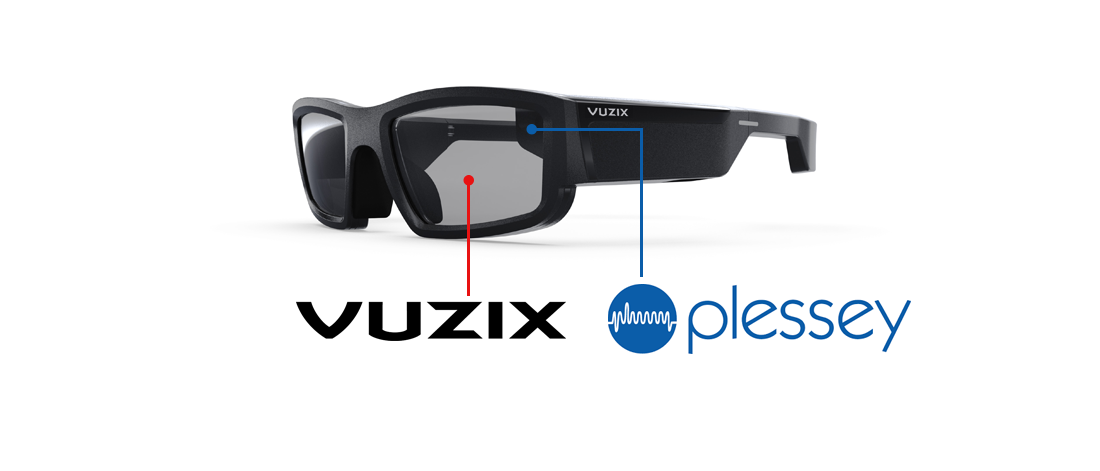
SO WHAT DOES PLESSEY ACTUALLY DO?
Some of the coverage made it clear that the writers did not understand what Plessey actually makes. Specifically in reference to Vuzix, VentureBeat wrote:
Plessey previously supplied smart glasses maker Vuzix with wearable screens, and has most recently focused on microLED technology, one of several display technologies competing for viability in future AR glasses.
Plessey did not supply Vuzix with “wearable screens”. Plessey supplied a component known as the light-engine for Vuzix’s waveguide—a component they manufacture themselves—that together comprise the two principle parts of a near-eye optics module. Let’s have a look.
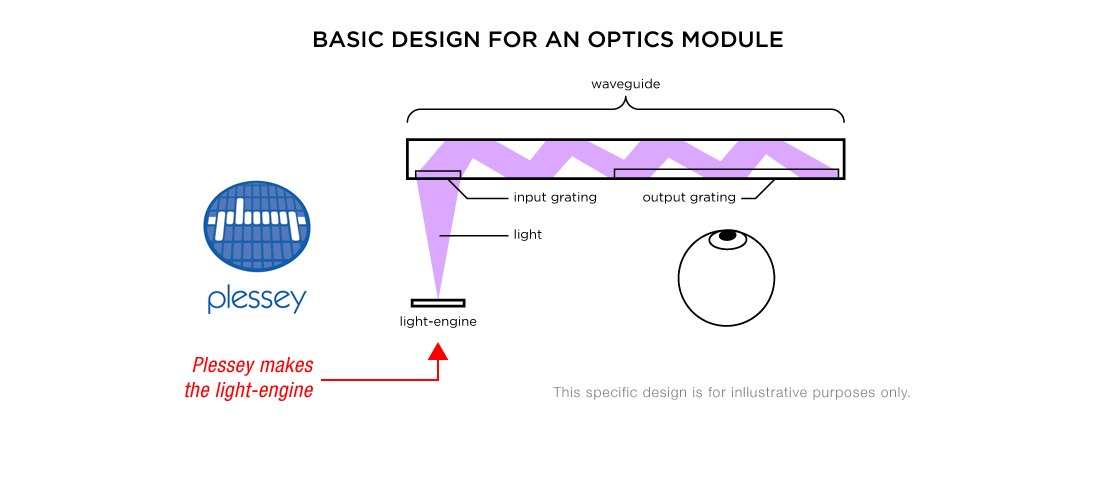
WHAT OTHER IMPORTANT RELATIONSHIPS DOES PLESSEY HAVE?
Plessey have several key strategic relationships. The uniqueness of Plessey’s offer is tied directly to many of these important relationships. Those which we will explore here include Jasper Display, Compound Photonics, and then we will look at WaveOptics, who bring their own set of relationships that will be explored below.
KEY PLESSEY RELATIONSHIPS
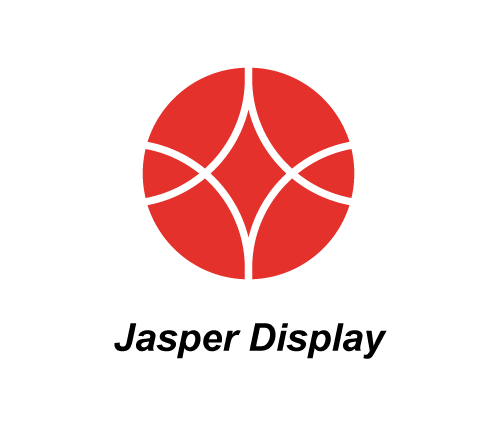 Jasper is a semiconductor company with whom Plessey partnered to codevelop their GaN-on-Si (Gallium Nitride on Silicon) backplane. Simply put, the backplane connects the MicroLED to the rest of the electronics. In the recent past the backplane for a MicroLED would have been sapphire-on-silicon (SoS). GaN-on-Si offer many advantages over SoS for MicroLEDs used as a light-engine in a near-eye-optics display. It has manufacturing cost advantages, higher brightness, lower power consumption, and given the unique property of “collimated light,” it simplifies the optics.
Jasper is a semiconductor company with whom Plessey partnered to codevelop their GaN-on-Si (Gallium Nitride on Silicon) backplane. Simply put, the backplane connects the MicroLED to the rest of the electronics. In the recent past the backplane for a MicroLED would have been sapphire-on-silicon (SoS). GaN-on-Si offer many advantages over SoS for MicroLEDs used as a light-engine in a near-eye-optics display. It has manufacturing cost advantages, higher brightness, lower power consumption, and given the unique property of “collimated light,” it simplifies the optics.
Clive Beech, Senior Director, Business Development at Plessey, explained last year in an interview with All About Circuits:

Over 130 separate layers go down before you end up at the top of the gallium nitride structure. They’re all very thin layers, so the total thickness of those layers is only of the order of three microns. Some [layers] are only a few nanometres thick, but all the different layers serve distinct purposes, in terms of matching the silicon crystal structures, the gallium nitride crystal structure… We can actually take the light from each pixel and instead of having what’s called Lambertian emission which is effectively in all directions, we can collimate it and bring that light into almost like a projector output, sending it directly into the lens and optics of the waveguide.
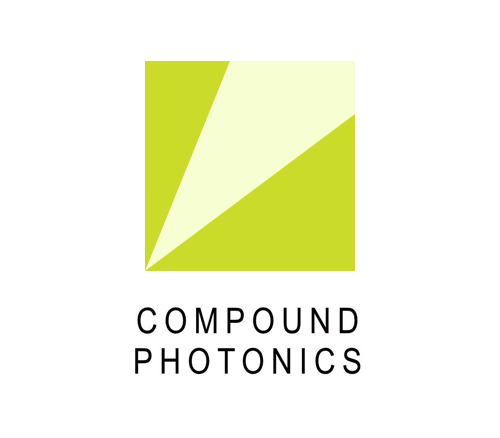 To fully realize their design in a productized form, Plessey partnered with Compound Photonics (CP) to design the module, as here explained in Compound Semiconductor Magazine:
To fully realize their design in a productized form, Plessey partnered with Compound Photonics (CP) to design the module, as here explained in Compound Semiconductor Magazine:
Under this partnership, Plessey will bond CP’s high speed digital low-latency backplane silicon wafer with Plessey’s proprietary GaN on Silicon monolithic microLED array wafer. In turn, CP will use its experience in microdisplay assembly, test, and packaging to create display modules from the bonded wafers in combination with CP’s NOVA high-performance display driver architecture to deliver a complete solution compatible with the industry standard MIPI display pipeline.
SO FAR…
So from the above, we can see that Facebook’s Plessey deal brings with it their own existing collection of partner relationships: Jasper works with Plessey to produce their backplane, and Compound Photonics works with Plessey to produce their module. These relationships are a given. Together they make the world’s smallest, highest resolution, low power consumption MicroLED displays for use as a light-engine to a waveguide.

BURIED THE LEAD AGAIN…
Now we’re going to get a little speculative… but not outlandishly so.
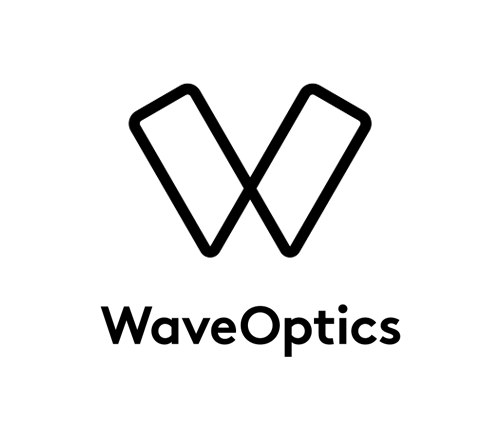 Plessey has a close relationship with a fellow UK based company, WaveOptics. Scarcely two months ago Plessey & WaveOptics announced a strategic partnership of their own. If Plessey has a partnership to develop a MicroLED to waveguide near-eye optics display module with WaveOptics, and if Plessey has an exclusivity supplier relationship with Facebook, then does it stand to reason that Facebook by extension will also be using WaveOptics waveguides?
Plessey has a close relationship with a fellow UK based company, WaveOptics. Scarcely two months ago Plessey & WaveOptics announced a strategic partnership of their own. If Plessey has a partnership to develop a MicroLED to waveguide near-eye optics display module with WaveOptics, and if Plessey has an exclusivity supplier relationship with Facebook, then does it stand to reason that Facebook by extension will also be using WaveOptics waveguides?
As they say in the business: Hardware is hard. Optics are harder.
Nobody—not The Information, nor VentureBeat, nor any other outlet I’ve seen cover the Facebook / Plessey deal—has explored this likelihood. Possibly because they don’t seem to understand the technology. Above, we saw that Plessey makes the light-engine component of the optics system. Yet nothing about WaveOptics has been disclosed, regarding the Facebook / Plessey deal. Here below we visualize how their partner WaveOptics makes the waveguide component of just such a system:
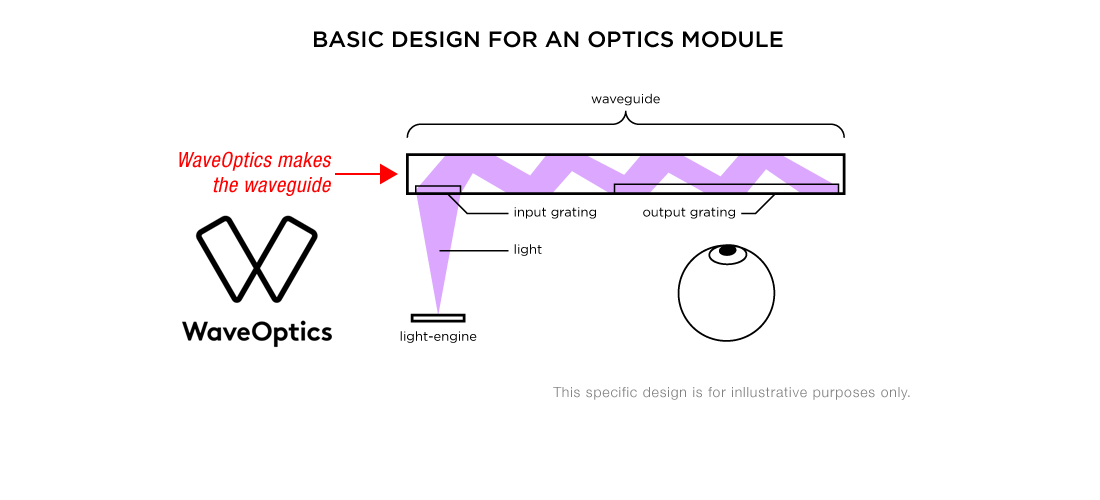
DOES FACEBOOK HAVE A WAVEGUIDE YET?
Being a vital component necessary to complete a near-eye optics displays system, does Facebook have any preexisting waveguide partnerships? Although they have some of their own IP, there is no publicly available information of any prior/existing Facebook waveguide supplier partnership… yet Plessey’s technology is effectively worthless to Facebook until they have a waveguide for it to illuminate.
SO… WHAT IF WAVEOPTICS ARE PART OF THE FACEBOOK DEAL?
If—as seems likely—through their partnership with Plessey, WaveOptics is including in the Facebook deal, we should also take a quick look at a couple of WaveOptics’ other partners.
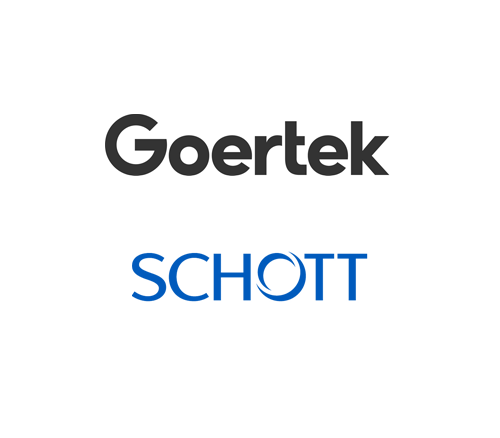 Two WaveOptics partners of note are Schott and Goertek. The former, Schott is a materials supplier that a mere few weeks ago entered into a contract to provide WaveOptics with the 1.8 Refraction Index RealView™ glass, used to make their waveguides. The later, Goertek is both one of WaveOptics largest investors, and a large Chinese manufacturer (perhaps most recently known for manufacturing Apple’s wireless AirPods) and who also have the exclusive contract to manufacture WaveOptics waveguides. The later is kind of a big deal. In response to U.S. / China trade relations, Goertek made a huge investment to diversify manufacturing outside of China, and in 2018 built their largest, newest factory in Vietnam.
Two WaveOptics partners of note are Schott and Goertek. The former, Schott is a materials supplier that a mere few weeks ago entered into a contract to provide WaveOptics with the 1.8 Refraction Index RealView™ glass, used to make their waveguides. The later, Goertek is both one of WaveOptics largest investors, and a large Chinese manufacturer (perhaps most recently known for manufacturing Apple’s wireless AirPods) and who also have the exclusive contract to manufacture WaveOptics waveguides. The later is kind of a big deal. In response to U.S. / China trade relations, Goertek made a huge investment to diversify manufacturing outside of China, and in 2018 built their largest, newest factory in Vietnam.
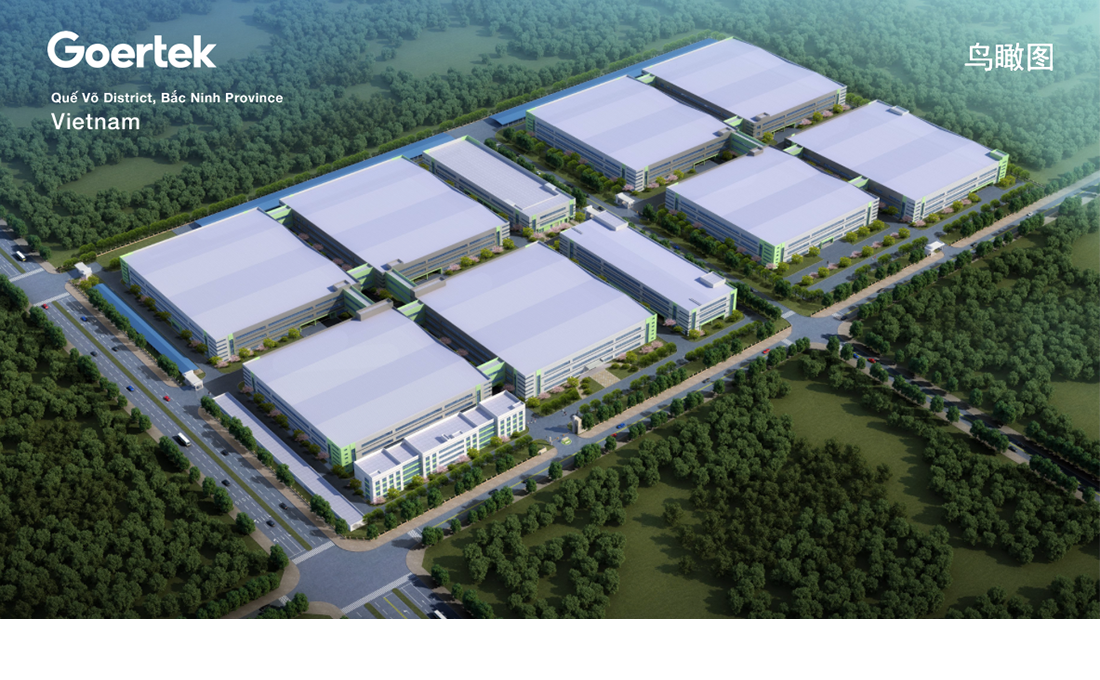
BUT WAIT, THERE’S MORE…
Just a quick reminder that last September Facebook—through a project code named Orion—was reported to be in talks with Luxottica to produce cobranded smartglasses. The CNBC article that broke the story made special note of Luxottica’s Ray-Ban brand, but it was not in any way clear that specifically a Ray-Ban designs would be involved. In any case, Facebook declined to comment and Luxottica did not respond to request for comment for that story (just as WaveOptics did not respond to requests for comment for this one).
SO WHAT DO WE KNOW?
We know that Facebook is working on a waveguide display strategy with a MicroLED light-engine. We know that Plessey has entered into a contract to give Facebook exclusive supply of their MicroLED light-engines for that display (and that Plessey has partnerships with Jasper to supply their backplane, and Compound Photonics to build their module). We also know that Facebook will need a waveguide for that light-engine to drive. While they have some IP, no existing Facebook waveguide contract is known to be in place. We know WaveOptics just signed a supplier partnership deal with Plessey that could appear to make them contractually bound to be a partner to the Facebook deal as well. Between Goertek’s investment in WaveOptics’ and their existing manufacturing license, a final optical system would most likely be assembled by Goertek (using Schott RealView™glass), and perhaps at their new factory in Vietnam.
It is also possible, if uncorroborated that the frames may be supplied by Luxottica.
A great deal can be learned—and even more informed speculation can be made— about Facebook’s future smartglasses, based on the recently revealed Plessey contract.
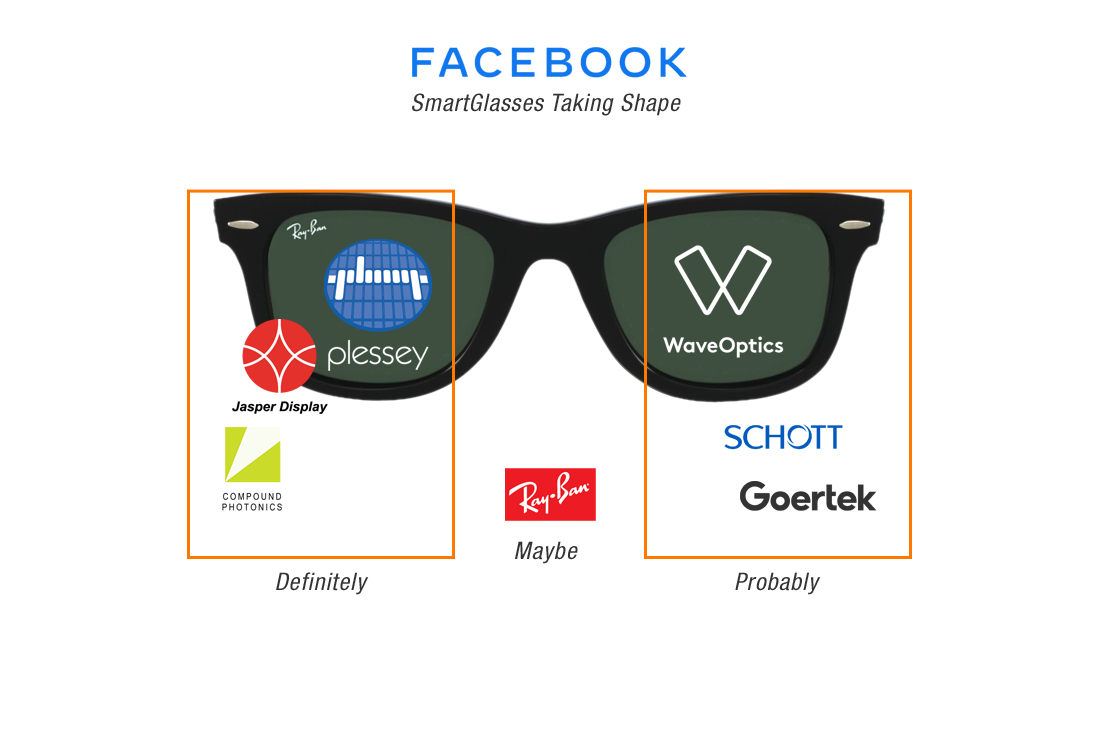

Christopher Grayson is a marketer, market analyst, writer, and former advertising creative director. He is available for consulting projects, editorial, and creative direction.
Contact: chris [at] chris grayson [dot] com
Readers can stay abreast of smartglasses, near-eye optics, and the fashion eye-frames industry—by following chris grayson on Twitter. In addition to publishing here at his blog GigantiCo, and at Linkedin Pulse, he has also been a contributing writer to UploadVR (largest tech publication dedicated to VR & AR), and to 20/20 Magazine (largest trade publication for optometrists & opticians).
